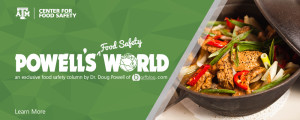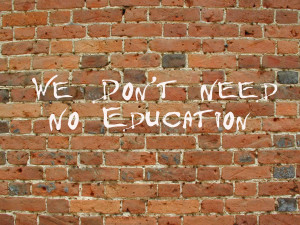Now that the annual orgy of food safety advice has subsided until the next holiday (that would be the Super Bowl, and all the bad puns), it’s time to ask: are any of these messages effective?
 Do they actually reduce the number of people who get sick? Does anyone test these messages in a scientifically credible way?
Do they actually reduce the number of people who get sick? Does anyone test these messages in a scientifically credible way?
Cook-clean-chill-separate has become the mantra of food safety types but there is no evidence — regardless of repetition — these messages work.
Instead, people are picking up sound bites like venereal diseases; I thought we’d gotten past that.
Marty had no reason going to the first food safety educators conference in Washington, D.C. in 1997. He was working as a student life advisor or something but, I had gotten in the habit of taking Marty along on road trips from Guelph – got lost once in some New York mountains in the middle of the night and thought we were going to die – for fun and driving chores.
The 1996 Nissan Quest minivan still had the new car smell, and as a new prof with a carload of students, I decided driving all night was better than dishing out non-existent cash for an extra night of hotel rooms.
We arrived in Georgetown about 7:30 a.m., ate at a dive, and found the on-campus conference room. People looked at us like we had just rolled out of a vehicle and been driving all night.
We had.
 Most of us went and changed into fresh clothes, while Marty crashed somewhere until the room was available.
Most of us went and changed into fresh clothes, while Marty crashed somewhere until the room was available.
The conference started and we were pumped.
I may have fallen asleep.
There were descriptions of many food safety education programs but the evaluation components were either non-existent or sucked.
I remember going out to a Georgetown bar later that night, watching The Truth About Cats and Dogs in the hotel room while Marty farted, and commenting that student Janis looked like Janeane Garofalo. I remember the drive home.
I don’t remember much about the conference.
Which is why I haven’t gone back.
I’m all for providing food safety information in a compelling, creative and critically sound manner. However education is something people do themselves. Lewis Lapham wrote in Harper’s magazine in the mid-1980s about how individuals can choose to educate themselves about all sorts of interesting things, but the idea of educating someone is doomed to failure. And it’s sorta arrogant to state that shoppers need to be educated; to imply that if only you understood the world as I understand the world, we would agree and dissent would be minimized.
These may be subtle semantics – to communicate with rather than to; to inform rather than educate – but they set an important tone.
With outbreaks in pizza, pot pies, pet food, peanut butter, bagged spinach, lettuce, sprouts, carrot juice, lettuce, tomatoes, canned chili sauce, hot peppers, cookie dough, chia seeds, tuna back scrape, and white pepper, I’m not sure what consumers have to do with it.
This is not to discount the role of consumers in protecting or enhancing the safety of the food they eat. Rather, consumers should be engaged as partners in the management of the farm-to-fork food continuum, and not unduly blamed for failing to recognize and correct errors that other players in this continuum have made.
Forget the blame; focus on shared responsibility; share information. Help people make better decisions. Tell them why what they do is important (if not yourself, try not to make your kids or friends barf).
The World Health Organization recognized this back in 2001 and included a fifth key to safer food: use safe water and raw materials, or, source food from safe sources (http://www.who.int/foodsafety/consumer/5keys/en/index.html).
I’m not sure what consumers are supposed to do about Listeria in caramel apples, but that’s another story.
Dr. Douglas Powell is a former professor of food safety who shops, cooks and ferments from his home in Brisbane, Australia.
Disclaimer: The views and opinions expressed in this blog are those of the original creator and do not necessarily represent that of the Texas A&M Center for Food Safety or Texas A&M University.
